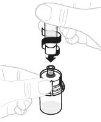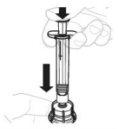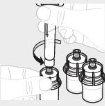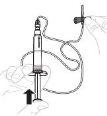
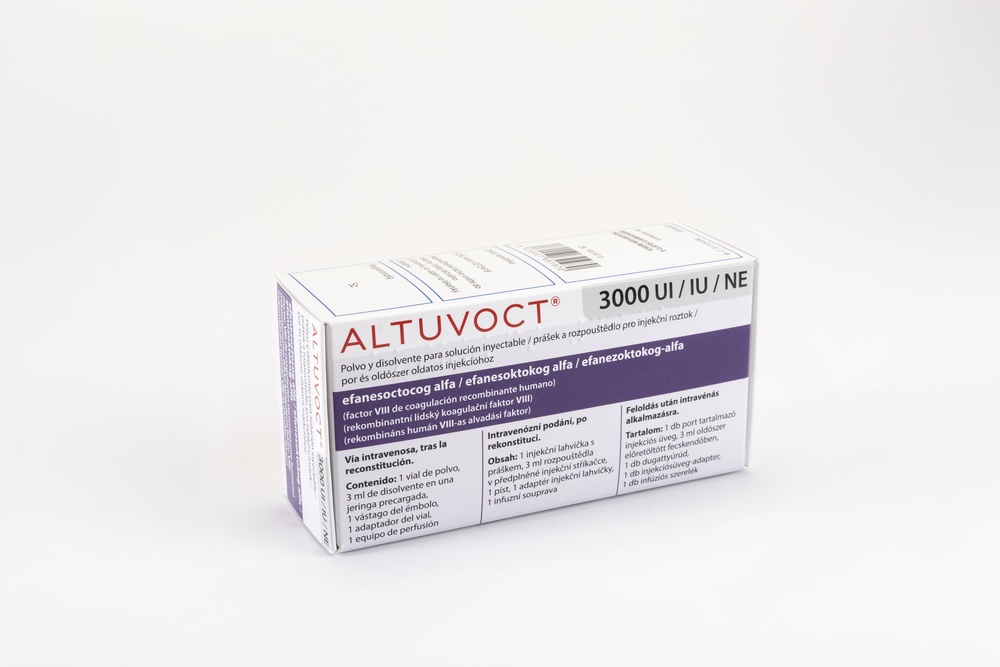
ALTUVOCT 3000 UI PÓ E SOLVENTE PARA SOLUÇÃO INJETÁVEL

Pergunte a um médico sobre a prescrição de ALTUVOCT 3000 UI PÓ E SOLVENTE PARA SOLUÇÃO INJETÁVEL

Como usar ALTUVOCT 3000 UI PÓ E SOLVENTE PARA SOLUÇÃO INJETÁVEL
Introdução
Prospecto: informação para o utilizador
ALTUVOCT 250 UI pó e dissolvente para solução injetável
ALTUVOCT 500 UI pó e dissolvente para solução injetável
ALTUVOCT 750 UI pó e dissolvente para solução injetável
ALTUVOCT 1 000 UI pó e dissolvente para solução injetável
ALTUVOCT 2 000 UI pó e dissolvente para solução injetável
ALTUVOCT 3 000 UI pó e dissolvente para solução injetável
ALTUVOCT 4 000 UI pó e dissolvente para solução injetável
efanesoctocog alfa (fator VIII de coagulação recombinante humano)
Este medicamento está sujeito a monitorização adicional, o que agilizará a detecção de nova informação sobre a sua segurança. Pode contribuir comunicando os efeitos adversos que possa ter. A parte final da secção 4 inclui informação sobre como comunicar estes efeitos adversos.
Leia todo o prospecto atentamente antes de começar a usar este medicamento, porque contém informação importante para si.
- Conserva este prospecto, porque pode ter que voltar a lê-lo.
- Se tiver alguma dúvida, consulte o seu médico, farmacêutico ou enfermeiro.
- Este medicamento foi-lhe prescrito apenas a si, e não deve dá-lo a outras pessoas, mesmo que tenham os mesmos sintomas que si, porque pode prejudicá-las.
- Se experimentar efeitos adversos, consulte o seu médico, farmacêutico ou enfermeiro, mesmo que se trate de efeitos adversos que não aparecem neste prospecto. Ver secção 4.
Conteúdo do prospecto
- O que é ALTUVOCT e para que é utilizado
- O que precisa saber antes de começar a usar ALTUVOCT
- Como usar ALTUVOCT
- Possíveis efeitos adversos
- Conservação de ALTUVOCT
- Conteúdo do envase e informação adicional
1. O que é ALTUVOCT e para que é utilizado
ALTUVOCT contém o princípio ativo efanesoctocog alfa, uma proteína de substituição do fator VIII.
ALTUVOCT é utilizado para tratar e prevenir os episódios hemorrágicos em doentes com hemofilia A (um distúrbio hemorrágico hereditário causado por uma deficiência do fator VIII) e pode ser utilizado em doentes de todas as idades.
O fator VIII é uma proteína presente de forma natural no corpo e é necessária para que o sangue forme coágulos e detenha as hemorragias. Nos doentes com hemofilia A, o fator VIII está ausente ou não funciona adequadamente.
ALTUVOCT substitui este «fator VIII» deficiente ou ausente. ALTUVOCT aumenta as concentrações de fator VIII no sangue, ajudando assim o sangue a formar coágulos no local de hemorragia, o que corrige temporariamente a tendência a sofrer hemorragias.
2. O que precisa saber antes de começar a usar ALTUVOCT
Não use ALTUVOCT
- se é alérgico a efanesoctocog alfa ou a algum dos outros componentes deste medicamento (incluídos na secção 6).
Advertências e precauções
Consulte o seu médico, farmacêutico ou enfermeiro antes de começar a usar ALTUVOCT.
- Existe uma rara possibilidade de que sofra uma reação anafiláctica (uma reação alérgica grave e repentina) a ALTUVOCT. Entre os sinais das reações alérgicas incluem-se picazón generalizado, erupções cutâneas, sensação de opressão no peito, dificuldade para respirar e pressão arterial baixa. Se aparecer algum destes sintomas, interrompa imediatamente a injeção e entre em contacto com o seu médico.
- Consulte o seu médico se acredita que não está a controlar as hemorragias ou as hemorragias do seu filho com a dose que recebe, porque podem existir vários motivos para isso. Em algumas pessoas que usam este medicamento podem desenvolver-se anticorpos contra o fator VIII (também conhecidos como inibidores do fator VIII). A formação de inibidores do fator VIII é uma complicação conhecida que pode ocorrer durante o tratamento com todos os medicamentos de fator VIII. Estes inibidores, especialmente a níveis altos, impedem que o tratamento actue adequadamente; será vigiada atentamente em si ou no seu filho a formação destes inibidores.
Eventos cardiovasculares
Se tem uma doença cardíaca ou corre o risco de a ter, tenha especial cuidado quando utilizar medicamentos de fator VIII e consulte o seu médico.
Complicações associadas ao catéter
Se necessita de um dispositivo de acesso venoso central (DAVC), deve ter-se em conta o risco de complicações relacionadas com o DAVC, incluindo as infecções locais, a presença de bactérias no sangue e a trombose no local de inserção do catéter.
Outros medicamentos e ALTUVOCT
Informa o seu médico se está a utilizar, utilizou recentemente ou possa ter que utilizar qualquer outro medicamento.
Gravidez e amamentação
Se está grávida ou em período de amamentação, acredita que possa estar grávida ou tem intenção de engravidar, consulte o seu médico antes de utilizar este medicamento.
Condução e uso de máquinas
A influência de ALTUVOCT sobre a capacidade para conduzir e utilizar máquinas é nula ou insignificante.
3. Como usar ALTUVOCT
O tratamento com ALTUVOCT será iniciado por um médico com experiência no cuidado de doentes com hemofilia A. ALTUVOCT é administrado mediante injeção em uma veia.
Depois de receber o treinamento necessário na técnica correcta de injeção, os doentes ou cuidadores podem administrar ALTUVOCT em casa. O seu médico calculará a sua dose (em unidades internacionais [UI]). Esta dependerá do seu peso e de se é utilizada para a prevenção ou para o tratamento das hemorragias.
Siga exactamente as instruções de administração deste medicamento indicadas pelo seu médico. Em caso de dúvida, consulte novamente o seu médico, farmacêutico ou enfermeiro.
Leve um registo
Cada vez que use ALTUVOCT, anote a data, o nome do medicamento e o número do lote.
Prevenção das hemorragias
A dose habitual de ALTUVOCT é de 50 unidades internacionais (UI) por quilograma de peso corporal. A injeção é administrada uma vez por semana.
Tratamento das hemorragias
A dose de ALTUVOCT é de 50 unidades internacionais (UI) por quilograma de peso corporal. A dose e a frequência podem ser ajustadas em função da gravidade e da localização da hemorragia.
Uso em crianças e adolescentes
ALTUVOCT pode ser utilizado em crianças de todas as idades; a recomendação relativa à dose é a mesma que nos adultos.
Como se administra ALTUVOCT
ALTUVOCT é administrado mediante injeção em uma veia. Consulte «Instruções sobre como usar ALTUVOCT» para mais informação.
Se usar mais ALTUVOCT do que deve
Informa o seu médico o mais breve possível. Siga exactamente as instruções de administração de ALTUVOCT indicadas pelo seu médico. Em caso de dúvida, consulte novamente o seu médico, farmacêutico ou enfermeiro.
Se esquecer de usar ALTUVOCT
Não injete uma dose dupla para compensar as doses esquecidas. Injete a sua dose assim que se lembrar e depois retome a sua pauta normal de dosificação. Se não tiver certeza do que deve fazer, consulte o seu médico, farmacêutico ou enfermeiro.
Se interromper o tratamento com ALTUVOCT
Se interromper o tratamento com ALTUVOCT, é possível que já não esteja protegido contra as hemorragias ou que uma hemorragia já existente não se detenha. Não interrompa o tratamento com ALTUVOCT sem consultar o seu médico.
Se tiver alguma outra dúvida sobre o uso deste medicamento, pergunte ao seu médico.
4. Possíveis efeitos adversos
Como todos os medicamentos, este medicamento pode produzir efeitos adversos, embora nem todas as pessoas os sofram.
Se se produzir uma reação anafiláctica, a injeção deve ser interrompida imediatamente e deve entrar em contacto imediatamente com o seu médico.
Os sintomas de uma reação anafiláctica são, entre outros, os seguintes:
|
|
Risco de formação de inibidores
Nas crianças que não receberam tratamento prévio com medicamentos de fator VIII, a formação de anticorpos inibidores (ver secção 2) é muito frequente (podem afectar mais de 1 em cada 10 doentes); no entanto, nos doentes que receberam tratamento prévio com fator VIII (mais de 150 dias de tratamento), o risco é pouco frequente (podem afectar até 1 em cada 100 doentes). Se si ou o seu filho experimentarem a formação de anticorpos inibidores, o medicamento pode deixar de actuar adequadamente e si ou o seu filho podem apresentar hemorragia persistente. Se isso ocorrer, deve entrar em contacto imediatamente com o seu médico.
Com este medicamento podem aparecer os seguintes efeitos adversos.
Efeitos adversos muito frequentes (podem afectar mais de 1 em cada 10 pessoas)
- dor de cabeça
- artralgia (dor articular)
Efeitos adversos frequentes (podem afectar até 1 em cada 10 pessoas)
- dor nas extremidades (braços, mãos, pernas ou pés)
- dor de costas
- eczema (picazón, vermelhidão ou secura da pele)
- erupção cutânea
- urticária (erupção com picazón)
- febre
- vómitos
Efeitos adversos pouco frequentes (podem afectar até 1 em cada 100 pessoas)
- reações no local de injeção (incluindo hematomas e inflamação)
Comunicação de efeitos adversos
Se experimentar qualquer tipo de efeito adverso, consulte o seu médico, farmacêutico ou enfermeiro, mesmo que se trate de possíveis efeitos adversos que não aparecem neste prospecto. Também pode comunicá-los directamente através do sistema nacional de notificação incluído no Apêndice V. Mediante a comunicação de efeitos adversos, pode contribuir para fornecer mais informação sobre a segurança deste medicamento.
5. Conservação de ALTUVOCT
Mantenha este medicamento fora da vista e do alcance das crianças.
Não utilize este medicamento após a data de validade que aparece na caixa e no frasco após «CAD/EXP». A data de validade é o último dia do mês que se indica.
Conservar em frigorífico (entre 2 ºC e 8 ºC).
Não congelar.
Conservar o frasco no embalagem exterior para protegê-lo da luz.
Antes da sua reconstituição, o pó de ALTUVOCT pode ser conservado a temperatura ambiente (≤ 30 ºC) durante um único período não superior a 6 meses. Deve ser anotada na caixa a data de extração do medicamento do frigorífico. Após a conservação a temperatura ambiente, o medicamento não deve ser novamente introduzido no frigorífico.
O medicamento não deve ser utilizado após a data de validade impressa no frasco ou seis meses após retirar a caixa do frigorífico, consoante a qual destas circunstâncias se produzir primeiro.
Uma vez que o pó de ALTUVOCT tenha sido dissolvido no dissolvente fornecido na seringa pré-carregada, deve ser utilizado imediatamente. Não refrigere a solução preparada.
Após a reconstituição, a solução deve ser transparente e entre incolor e ligeiramente opalescente. Não utilize este medicamento se observar que está turvo ou contém partículas visíveis.
Os medicamentos não devem ser deitados fora por los despejos nem para o lixo. Pergunte ao seu farmacêutico como se deve livrar dos envases e dos medicamentos que já não precisa. Desta forma, ajudará a proteger o meio ambiente.
6. Conteúdo do frasco e informações adicionais
Composição de ALTUVOCT
- O princípio ativo é efanesoctocogo alfa (fator VIII de coagulação recombinante humano).
Cada frasco de ALTUVOCT contém nominalmente 250, 500, 750, 1 000, 2 000, 3 000 ou 4 000 UI de efanesoctocogo alfa.
- Os demais componentes são sacarose, cloreto de cálcio diidratado, histidina, cloridrato de arginina e polissorbato 80.
Aspecto do produto e conteúdo do frasco
ALTUVOCT é apresentado sob a forma de pó e diluente para solução injetável. O pó é um pó solto ou compacto de cor branca a esbranquiçada. O diluente fornecido para a preparação da solução injetável é uma solução transparente e incolor. Após a preparação, a solução injetável é transparente e entre incolor e ligeiramente opalescente.
Cada frasco de ALTUVOCT contém 1 frasco de pó, 3 ml de diluente em uma seringa pré-carregada, 1 êmbolo, 1 adaptador do frasco e 1 equipamento de perfusão.
Título da autorização de comercialização e responsável pela fabricação
Swedish Orphan Biovitrum AB (publ)
SE-112 76 Estocolmo
Suécia
Swedish Orphan Biovitrum AB (publ)
Norra Stationsgatan 93
113 64 Estocolmo
Suécia
Data da última revisão deste prospecto:
A informação detalhada deste medicamento está disponível no site da Agência Europeia de Medicamentos: https://www.ema.europa.eu.
Vire o prospecto para ver as instruções para a preparação e administração do medicamento.
Instruções sobre como usar ALTUVOCT
LEIA ATENTAMENTE ESTAS INSTRUÇÕES ANTES DE USAR ALTUVOCT
ALTUVOCT é administrado por injeção intravenosa após dissolver o pó injetável com o diluente fornecido na seringa pré-carregada.
Se a sua dose requer mais de um frasco, você receberá vários frascos e, idealmente, uma seringa grande.
Seu profissional de saúde deve ensinar-lhe a preparar e injetar corretamente ALTUVOCT antes de usá-lo pela primeira vez. Pergunte a seu profissional de saúde se tiver alguma dúvida.
Informação importante
Verifique se o nome e a dose do medicamento estão corretos e se você conhece a frequência de administração de ALTUVOCT.
Não use o medicamento se estiver vencido, foi aberto ou parece estar danificado.
ALTUVOCT não deve ser misturado com outras soluções injetáveis.
Idealmente, ALTUVOCT deve ser armazenado na geladeira. Deixe o frasco e a seringa de diluente atingirem a temperatura ambiente antes do uso. Não use calor externo.
Verifique se nenhum dos elementos apresenta danos antes de usá-los; não os use se parecerem estar danificados.
Todos os elementos são válidos para um único uso.
Lave as mãos e limpe uma superfície plana antes de preparar o kit. Coloque a seringa de forma segura sobre uma superfície plana quando não a estiver manipulando.
Guia dos elementos (incluídos na caixa)
ALTUVOCT é reconstituído dissolvendo o pó injetável (A) no diluente fornecido na seringa pré-carregada (B). Posteriormente, a solução de ALTUVOCT deve ser administrada usando o equipamento de perfusão (E).
|
|
|
|
|
pó |
(pré-carregada com diluente) |
frasco |
do frasco |
perfusão |
Elementos adicionais (não incluídos na caixa)
Certifique-se de que dispõe de toalhetes com álcool (F).
É possível que seu farmacêutico tenha fornecido uma seringa grande separadamente (G) para extrair a solução de vários frascos para uma única seringa. Se NÃO lhe foi fornecida uma seringa grande, siga os passos do 6 ao 8 para administrar a solução de cada seringa.
|
|
|
|
Reconstituição
| |
Segure o frasco de pó (A) sobre uma superfície limpa e plana e retire a tampa de fechamento de plástico. |
|
Limpe a parte superior do frasco com um toalhete com álcool. Certifique-se de que nada entre em contato com a parte superior do frasco uma vez que o tenha limpo. |
|
Desprenda a tampa protetora de papel do envase do adaptador do frasco (D). Não toque no adaptador do frasco nem o retire de seu envase. |
|
Coloque o envase do adaptador do frasco diretamente sobre a parte superior do frasco. Pressione firmemente para baixo até que o adaptador encaixe em sua posição. O perfurador atravessará a tampa do frasco. |
|
| |
Insira o êmbolo (C) na seringa de 3 ml (B). Gire o êmbolo no sentido horário até que fique bem acoplado. |
|
Separe a parte superior da tampa de fechamento da seringa de 3 ml pelas perfurações e deixe-a de lado. Não toque no interior da tampa de fechamento nem na ponta da seringa. |
|
| |
Levante o envase para separá-lo do adaptador do frasco e descarte-o. |
|
Segure o adaptador do frasco pelo extremo inferior. Coloque a ponta da seringa sobre a parte superior do adaptador do frasco. Gire a seringa no sentido horário até que fique bem acoplada. |
|
| |
Pressione lentamente o êmbolo para injetar todo o diluente no frasco. |
|
Com o polegar sobre o êmbolo, mova suavemente em círculos o frasco até que o pó se dissolva. Não o agite. |
|
Examine a solução antes de sua administração. Deve ser transparente e incolor. Não use a solução se estiver turva ou contiver partículas visíveis. | |
| |
Se a sua dose requer mais de um frasco, siga os passos indicados a seguir (5a e 5b); de outra forma, siga no passo 6. | |
Repita os passos do 1 ao 4 com todos os frascos até que tenha preparado uma quantidade suficiente de solução para a sua dose. Retire as seringas de 3 ml de cada frasco (ver passo 6b), deixando a solução em cada frasco. |
|
Para cada frasco, acople a seringa grande (G) ao adaptador do frasco (ver passo 3b) e realize o passo 6 para combinar a solução de cada frasco na seringa grande. Se apenas precisar de parte de um frasco inteiro, use a escala de graduação da seringa para ver a quantidade de solução que extrai, conforme indicado por seu profissional de saúde. |
|
| |
Coloque a seringa apontando para cima. Puxe lentamente o êmbolo para transferir toda a solução para o interior da seringa. |
|
Desacople a seringa do frasco segurando o adaptador do frasco. Gire a seringa no sentido anti-horário para desacoplá-la. |
|
Administração
| |
Abra o envase do equipamento de perfusão (E) (não o use se estiver danificado). Retire a tampa de fechamento do tubo. Não toque no extremo exposto do tubo. |
|
Acople a seringa preparada ao extremo do tubo do equipamento de perfusão girando a seringa no sentido horário. |
|
Se necessário, aplique um torniquete. Limpe o local de injeção com um toalhete com álcool (F). |
|
Extraia o ar colocando a seringa apontando para cima e pressionando suavemente o êmbolo. Não empurre a solução através da agulha. A injeção de ar na veia pode ser perigosa. |
|
| |
Retire a cobertura protetora da agulha. Insira a agulha em uma veia, conforme indicado por seu médico ou enfermeiro, e retire o torniquete se o tiver aplicado. Pode usar uma tirita para segurar as asas de plástico da agulha em sua posição no local de injeção para evitar que se mova. | |
A solução preparada deve ser injetada por via intravenosa entre 1 e 10 minutos, dependendo do grau de confort do paciente. | |
| |
Retire a agulha. Dobre o protetor da agulha; deve encaixar em sua posição. |
|
Elimine de forma segura a agulha usada, todo o resto de solução não utilizado, a seringa e o frasco vazio em um contenedor de resíduos médicos apropriado. Não reutilize o instrumental. |
- País de registo
- Substância ativa
- Requer receita médicaSim
- Fabricante
- Esta informação é apenas para referência e não constitui aconselhamento médico. Consulte sempre um médico antes de tomar qualquer medicamento. A Oladoctor não se responsabiliza por decisões médicas baseadas neste conteúdo.
- Alternativas a ALTUVOCT 3000 UI PÓ E SOLVENTE PARA SOLUÇÃO INJETÁVELForma farmacêutica: INJETÁVEL, 1.000 UISubstância ativa: coagulation factor VIIIFabricante: Takeda Manufacturing Austria AgRequer receita médicaForma farmacêutica: INJETÁVEL, 1500 UISubstância ativa: coagulation factor VIIIFabricante: Takeda Manufacturing Austria AgRequer receita médicaForma farmacêutica: INJETÁVEL, 1000 UI - após reconstituição em 2 ml de água para injetáveis, a dose é de 500 UI/mlSubstância ativa: coagulation factor VIIIFabricante: Takeda Manufacturing Austria AgRequer receita médica
Alternativas a ALTUVOCT 3000 UI PÓ E SOLVENTE PARA SOLUÇÃO INJETÁVEL noutros países
As melhores alternativas com o mesmo princípio ativo e efeito terapêutico.
Alternativa a ALTUVOCT 3000 UI PÓ E SOLVENTE PARA SOLUÇÃO INJETÁVEL em Polónia
Alternativa a ALTUVOCT 3000 UI PÓ E SOLVENTE PARA SOLUÇÃO INJETÁVEL em Ukraine
Médicos online para ALTUVOCT 3000 UI PÓ E SOLVENTE PARA SOLUÇÃO INJETÁVEL
Avaliação de posologia, efeitos secundários, interações, contraindicações e renovação da receita de ALTUVOCT 3000 UI PÓ E SOLVENTE PARA SOLUÇÃO INJETÁVEL – sujeita a avaliação médica e regras locais.


















